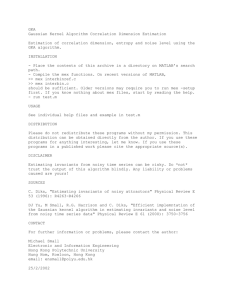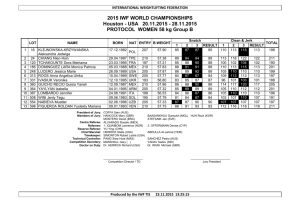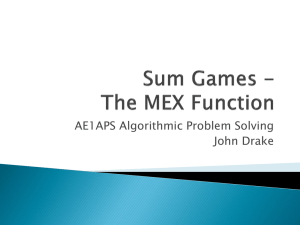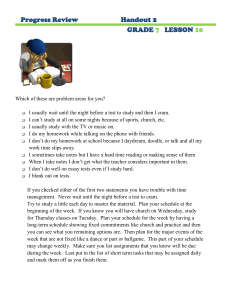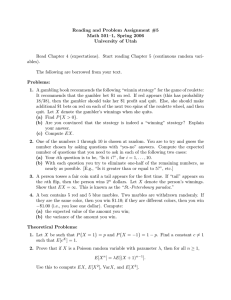, Lecture 3 Feb 16, 2010
advertisement
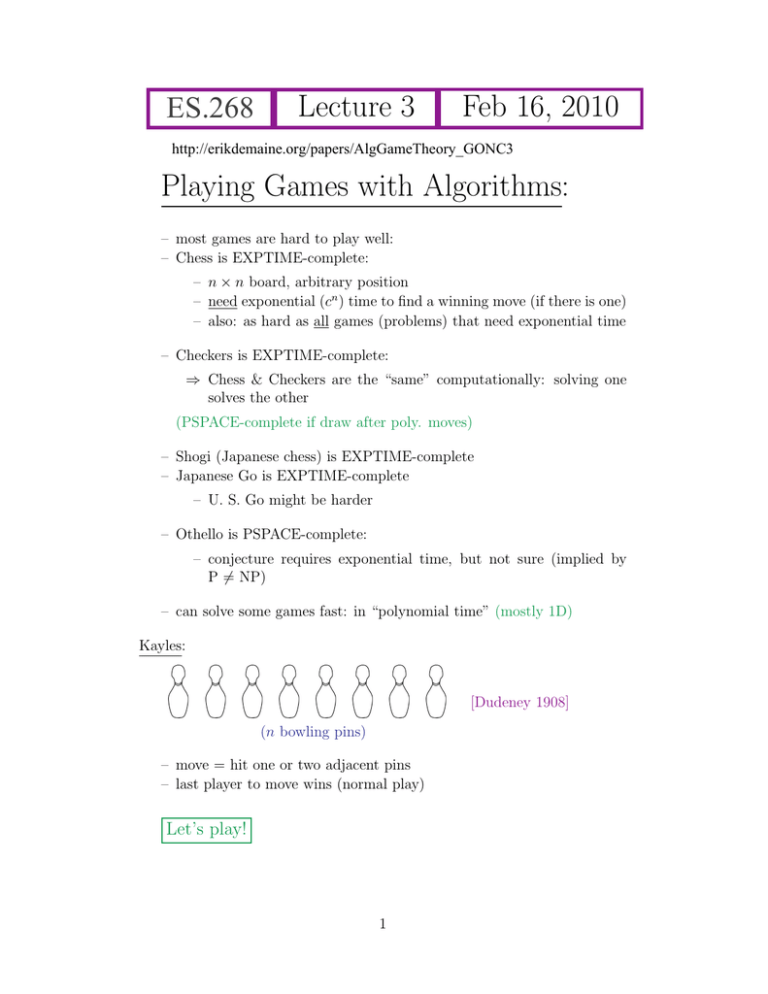
ES.268 ,
Lecture 3 , Feb 16, 2010
http://erikdemaine.org/papers/AlgGameTheory_GONC3
Playing Games with Algorithms:
– most games are hard to play well:
– Chess is EXPTIME-complete:
– n × n board, arbitrary position
– need exponential (cn ) time to find a winning move (if there is one)
– also: as hard as all games (problems) that need exponential time
– Checkers is EXPTIME-complete:
⇒ Chess & Checkers are the “same” computationally: solving one
solves the other
(PSPACE-complete if draw after poly. moves)
– Shogi (Japanese chess) is EXPTIME-complete
– Japanese Go is EXPTIME-complete
– U. S. Go might be harder
– Othello is PSPACE-complete:
– conjecture requires exponential time, but not sure (implied by
P �= NP)
– can solve some games fast: in “polynomial time” (mostly 1D)
Kayles:
[Dudeney 1908]
(n bowling pins)
– move = hit one or two adjacent pins
– last player to move wins (normal play)
Let’s play!
1
First-player win:
SYMMETRY STRATEGY
– move to split into two equal halves (1 pin if odd, 2 if even)
– whatever opponent does, do same in other half
(Kn + Kn = 0 . . . just like Nim)
Impartial game, so Sprague-Grundy Theory says Kayles ≡ Nim somehow
= {Ki + Kn−i−1 , Ki + Kn−i−2 | i = 0, 1, . . . , n − 2}
= mex{nimber(Ki + Kn−i−1 ),
nimber(Ki + Kn−i−2 )
| i = 0, 1, . . . , n − 2}
– nimber(x + y) = nimber(x) ⊕ nimber(y)
⇒ nimber(Kn ) = mex{nimber(Ki ) ⊕ nimber(Kn−i−1 ),
nimber(Ki ) ⊕ nimber(Kn−i−2 )
| i = 0, 1, . . . n − 2}
– followers(Kn )
⇒ nimber(Kn )
RECURRENCE! — write what you want in terms of smaller things
How do we compute it?
nimber(K0 ) = 0
nimber(K1 )
=
=
nimber(K2 )
=
=
(BASE CASE)
mex{nimber(K0 ) ⊕ nimber(K0 )}
0
⊕ 0 = 0
1
mex{nimber(K0 ) ⊕ nimber(K1 ),
0
⊕ 1 = 1
nimber(K0 ) ⊕ nimber(K0 )}
0
⊕ 0 = 0
2
so e.g. K2 + ∗2 = 0 ⇒ 2nd player win
nimber(K3 )
=
=
mex{nimber(K0 ) ⊕ nimber(K2 ),
0
⊕ 2 = 2
nimber(K0 ) ⊕ nimber(K1 ),
0
⊕ 1 = 1
nimber(K1 ) ⊕ nimber(K1 )}
1
⊕ 1 = 0
3
2
nimber(K4 )
=
=
mex{nimber(K0 ) ⊕ nimber(K3 ),
0
⊕ 3 = 3
nimber(K0 ) ⊕ nimber(K2 ),
0
⊕ 2 = 2
nimber(K1 ) ⊕ nimber(K2 ),
1
⊕ 2 = 3
nimber(K1 ) ⊕ nimber(K1 )}
1
⊕ 1 = 0
1
In general: if we compute nimber(K0 ), nimber(K1 ), nimber(K2 ), . . . in order,
then we always use nimbers that we’ve already computed (because smaller)
– in Python, can do this with for loop:
k = {}
for n in range(0, 1000):
k[n] = mex ([k[i] ˆ k[n - i - 1] for i in range(n)] +
[k[i] ˆ k[n - i - 2] for i in range(n - 1)])
print n, ”-”, k[ ]
def mex(nimbers):
nimbers = set(nimbers)
n=0
while n in nimbers:
n=n+1
return n
960 – 4
972 – 4
961 – 1
973 – 1
962 – 2
974 – 2
963 – 8
975 – 8
964 – 1
976 – 1
965 – 4
977 – 4
966 – 7
978 – 7
967 – 2
979 – 2
968 – 1
980 – 1
969 – 8
981 – 8
970 – 2
982 – 2
971 – 7
983 – 7
periodic mod 12!
(starting at ‘72)
[Guy & Smith 1972]
DYNAMIC PROGRAMMING
How fast? to compute nimber(Kn ):
–
–
–
–
–
look up ≈ 4n previous nimbers
compute ≈ 2n nimsums (XOR)
compute one mex on ≈ 2n nimbers
call all this O(n) work “order n”
need to do this for n = 0, 1, . . . , m
� m �
�
�
m
�
�
m(m + 1)
⇒
n = O
= O(n2 )
O(n) = O
2
n=0
n=0
POLYNOMIAL TIME — GOOD
3
984
985
986
987
988
989
990
991
992
993
994
995
–
–
–
–
–
–
–
–
–
–
–
–
4
1
2
8
1
4
7
2
1
8
2
7
Variations: dynamic programming also works for:
– Kayles on a cycle
(1 move reduces to regular Kayles ⇒ 2nd player win)
target vertex or 2 adj. vertices
– Kayles on a tree:
– Kayles with various ball sizes: hit 1 or 2 or 3 pins
(still 1st player win)
Cram: impartial Domineering
– board = m × n rectangle, possibly with holes
– move = place a domino (make 1 × 2 hole)
Symmetry strategies:
[Gardner 1986]
– even × even: reflect in both axes
⇒ 1st player win
– even × odd: play 2 center �s then reflect in both axes
⇒ 1st player win
– odd × odd: OPEN
who wins?
Liner Cram = 1 × n cram
– easy with dynamic programming
– also periodic
[Guy & Smith 1956]
– 1 × 3 blocks still easy with DP
–
OPEN : periodic?
Horizontal Cram:
1 only
⇒
sum of linear crams!
Let’s play!
2 × n Cram: Nimbers
OPEN
3 × n Cram: winner OPEN
(dynamic programming doesn’t work)
4
MIT OpenCourseWare
http://ocw.mit.edu
ES.268 The Mathematics in Toys and Games
Spring 2010
For information about citing these materials or our Terms of Use, visit: http://ocw.mit.edu/terms.
